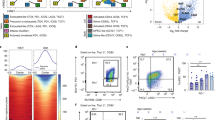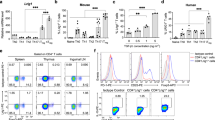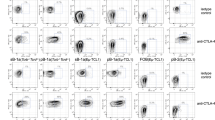Abstract
The inhibitory immunoregulatory receptor CTLA-4 is critical in maintaining self-tolerance, but the mechanisms of its actions have remained controversial. Here we examined the antigen specificity of tissue-infiltrating CD4+ T cells in Ctla4−/− mice. After adoptive transfer, T cells isolated from tissues of Ctla4−/− mice showed T cell antigen receptor (TCR)-dependent accumulation in the tissues from which they were derived, which suggested reactivity to tissue-specific antigens. We identified the pancreas-specific enzyme PDIA2 as an autoantigen in Ctla4−/− mice. CTLA-4 expressed either on PDIA2-specific effector cells or on regulatory T cells was sufficient to control tissue destruction mediated by PDIA2-specific T cells. Our results demonstrate that both cell-intrinsic and non–cell-autonomous actions of CTLA-4 operate to maintain T cell tolerance to a self antigen.
This is a preview of subscription content, access via your institution
Access options
Subscribe to this journal
Receive 12 print issues and online access
$209.00 per year
only $17.42 per issue
Buy this article
- Purchase on Springer Link
- Instant access to full article PDF
Prices may be subject to local taxes which are calculated during checkout







Similar content being viewed by others
References
Alegre, M.L., Frauwirth, K.A. & Thompson, C.B. T-cell regulation by CD28 and CTLA-4. Nat. Rev. Immunol. 1, 220–228 (2001).
Tivol, E.A. et al. Loss of CTLA-4 leads to massive lymphoproliferation and fatal multiorgan tissue destruction, revealing a critical negative regulatory role of CTLA-4. Immunity 3, 541–547 (1995).
Waterhouse, P. et al. Lymphoproliferative disorders with early lethality in mice deficient in Ctla-4. Science 270, 985–988 (1995).
Chambers, C.A. et al. Thymocyte development is normal in CTLA-4-deficient mice. Proc. Natl. Acad. Sci. USA 94, 9296–9301 (1997).
Scalapino, K.J. & Daikh, D.I. CTLA-4: a key regulatory point in the control of autoimmune disease. Immunol. Rev. 223, 143–155 (2008).
van der Merwe, P.A. et al. CD80 (B7–1) binds both CD28 and CTLA-4 with a low affinity and very fast kinetics. J. Exp. Med. 185, 393–403 (1997).
Ostrov, D.A. et al. Structure of murine CTLA-4 and its role in modulating T cell responsiveness. Science 290, 816–819 (2000).
Walunas, T.L., Bakker, C.Y. & Bluestone, J.A. CTLA-4 ligation blocks CD28-dependent T cell activation. J. Exp. Med. 183, 2541–2550 (1996).
Krummel, M.F. & Allison, J.P. CTLA-4 engagement inhibits IL-2 accumulation and cell cycle progression upon activation of resting T cells. J. Exp. Med. 183, 2533–2540 (1996).
Fallarino, F., Fields, P.E. & Gajewski, T.F. B7–1 engagement of cytotoxic T lymphocyte antigen 4 inhibits T cell activation in the absence of CD28. J. Exp. Med. 188, 205–210 (1998).
Schneider, H. et al. Reversal of the TCR stop signal by CTLA-4. Science 313, 1972–1975 (2006).
Bachmann, M.F. et al. Cutting edge: lymphoproliferative disease in the absence of CTLA-4 is not T cell autonomous. J. Immunol. 163, 1128–1131 (1999).
Friedline, R.H. et al. CD4+ regulatory T cells require CTLA-4 for the maintenance of systemic tolerance. J. Exp. Med. 206, 421–434 (2009).
Tang, Q. et al. Distinct roles of CTLA-4 and TGF-β in CD4+CD25+ regulatory T cell function. Eur. J. Immunol. 34, 2996–3005 (2004).
Kataoka, H. et al. CD25+CD4+ regulatory T cells exert in vitro suppressive activity independent of CTLA-4. Int. Immunol. 17, 421–427 (2005).
Wing, K. et al. CTLA-4 control over Foxp3+ regulatory T cell function. Science 322, 271–275 (2008).
Onishi, Y. et al. Foxp3+ natural regulatory T cells preferentially form aggregates on dendritic cells in vitro and actively inhibit their maturation. Proc. Natl. Acad. Sci. USA 105, 10113–10118 (2008).
Perez, V.L. et al. Induction of peripheral T cell tolerance in vivo requires CTLA-4 engagement. Immunity 6, 411–417 (1997).
Chambers, C.A., Kuhns, M.S. & Allison, J.P. Cytotoxic T lymphocyte antigen-4 (CTLA-4) regulates primary and secondary peptide-specific CD4+ T cell responses. Proc. Natl. Acad. Sci. USA 96, 8603–8608 (1999).
Gozalo-Sanmillan, S. et al. Cutting edge: Two distinct mechanisms lead to impaired T cell homeostasis in Janus kinase 3- and CTLA-4-deficient mice. J. Immunol. 166, 727–730 (2001).
Ueda, H. et al. Association of the T-cell regulatory gene CTLA4 with susceptibility to autoimmune disease. Nature 423, 506–511 (2003).
Peggs, K.S. et al. Principles and use of anti-CTLA4 antibody in human cancer immunotherapy. Curr. Opin. Immunol. 18, 206–213 (2006).
Hsieh, C.S. et al. Recognition of the peripheral self by naturally arising CD25+CD4+ T cell receptors. Immunity 21, 267–277 (2004).
Pacholczyk, R. et al. Origin and T cell receptor diversity of Foxo3+CD4+CD25+ T cells. Immunity 25, 249–259 (2006).
Shinkai, Y. et al. Restoration of T cell development in RAG-2-deficient mice by functional TCR transgenes. Science 259, 822–825 (1993).
Allison, J.P. et al. A role for CTLA-4 mediated inhibitory signals in peripheral T cell tolerance? Novartis Found. Symp. 1998, 92–102 (1998).
Vijayakrishnan, L. et al. An autoimmune disease-associated CTLA4 splice variant lacking the B7 binding domain signals negatively in T cells. Novartis Found. Symp. 2005, 200–218 (2005).
Niki, S. et al. Alteration of intra-pancreatic target-organ specificity by abrogation of Aire in NOD mice. J. Clin. Invest. 116, 1292–1301 (2006).
Okazaki, K., Uchida, K. & Chiba, T. Recent concept of autoimmune-related pancreatitis. J. Gastroenterol. 36, 293–302 (2001).
Meagher, C. et al. Spontaneous development of a pancreatic exocrine disease in CD28-deficient NOD mice. J. Immunol. 180, 7793–7803 (2008).
Schmidt, E.M. et al. CTLA-4 controls regulatory T cell peripheral homeostasis and is required for suppression of pancreatic islet autoimmunity. J. Immunol. 182, 274–282 (2009).
Yin, L., Schneider, H. & Rudd, C.E. Short cytoplasmic SDYMNM segment of CD28 is sufficient to convert CTLA-4 to a positive signaling receptor. J. Leukoc. Biol. 73, 178–182 (2003).
Hueber, A.J. et al. CTLA-4 lacking the cytoplasmic domain costimulates IL-2 production in T-cell hybridomas. Immunol. Cell Biol. 84, 51–58 (2006).
Paust, S. et al. Engagement of B7 on effector T cells by regulatory T cells prevents autoimmune disease. Proc. Natl. Acad. Sci. USA 101, 10398–10403 (2004).
Grohmann, U. et al. CTLA-4-Ig regulates tryptophan catabolism in vivo. Nat. Immunol. 3, 1097–1101 (2002).
Gough, S.C., Walker, L.S. & Sansom, D.M. CTLA4 gene polymorphism and autoimmunity. Immunol. Rev. 204, 102–115 (2005).
Goldrath, A.W. & Bevan, M.J. Selecting and maintaining a diverse T-cell repertoire. Nature 402, 255–262 (1999).
Seddon, B. et al. Long-term survival but impaired homeostatic proliferation of naive T cells in the absence of p56lck. Science 290, 127–131 (2000).
Tivol, E.A. & Gorski, J. Re-establishing peripheral tolerance in the absence of CTLA-4: complementation by wild-type T cells points to an indirect role for CTLA-4. J. Immunol. 169, 1852–1858 (2002).
Anderson, M.S. et al. The cellular mechanism of Aire control of T cell tolerance. Immunity 23, 227–239 (2005).
Eggena, M.P. et al. Cooperative roles of CTLA-4 and regulatory T cells in tolerance to an islet cell antigen. J. Exp. Med. 199, 1725–1730 (2004).
Peggs, K.S. et al. Blockade of CTLA-4 on both effector and regulatory T cell compartments contributes to the antitumor activity of anti-CTLA-4 antibodies. J. Exp. Med. 206, 1717–1725 (2009).
Murphy, K.M., Heimberger, A.B. & Loh, D.Y. Induction by antigen of intrathymic apoptosis of CD4+CD8+TCRlo thymocytes in vivo. Science 250, 1720–1723 (1990).
Shimizu, J., Kanagawa, O. & Unanue, E.R. Presentation of beta-cell antigens to CD4+ and CD8+ T cells of non-obese diabetic mice. J. Immunol. 151, 1723–1730 (1993).
Zhu, H. et al. Unexpected characteristics of the IFN-γ reporters in nontransformed T cells. J. Immunol. 167, 855–865 (2001).
Ohtsuka, M. et al. NFAM1, an immunoreceptor tyrosine-based activation motif-bearing molecule that regulates B cell development and signaling. Proc. Natl. Acad. Sci. USA 101, 8126–8131 (2004).
Ouyang, W. et al. Inhibition of Th1 development mediated by GATA-3 through an IL-4-independent mechanism. Immunity 9, 745–755 (1998).
Berenson, L.S. et al. Selective requirement of p38α MAPK in cytokine-dependent, but not antigen receptor-dependent, Th1 responses. J. Immunol. 176, 4616–4621 (2006).
Sedy, J.R. et al. B and T lymphocyte attenuator regulates T cell activation through interaction with herpesvirus entry mediator. Nat. Immunol. 6, 90–98 (2005).
Backstrom, B.T. et al. A motif within the T cell receptor α chain constant region connecting peptide domain controls antigen responsiveness. Immunity 5, 437–447 (1996).
Acknowledgements
We thank W. Sha (University of California Berkeley) for the MSCV IRES-Thy-1.1 retrovirus; M. Iwashima (Medical College of Georgia) for pKS-NFAT-GFP; and M. Hurchla, M. Sandau and B. Schraml for critically reading the manuscript. Supported by the Howard Hughes Medical Institute (K.M.M.) and the US National Institutes of Health (AI031238 and AI070489 to K.M.M.).
Author information
Authors and Affiliations
Contributions
W.I. designed experiments, did research, analyzed and interpreted results and wrote the manuscript; M.K. did TCRα cDNA cloning; K.M.N. and H.M.L. helped generate the TCRα library; A.S. and E.R.U. provided beta cells and contributed to the hybridoma assay; T.L.M. helped sort cells and contributed to the generation of the TCRα library; and K.M.M. directed the study, analyzed and interpreted results and wrote the manuscript.
Corresponding author
Supplementary information
Supplementary Text and Figures
Supplementary Figures 1–10 (PDF 497 kb)
Rights and permissions
About this article
Cite this article
Ise, W., Kohyama, M., Nutsch, K. et al. CTLA-4 suppresses the pathogenicity of self antigen–specific T cells by cell-intrinsic and cell-extrinsic mechanisms. Nat Immunol 11, 129–135 (2010). https://doi.org/10.1038/ni.1835
Received:
Accepted:
Published:
Issue Date:
DOI: https://doi.org/10.1038/ni.1835
This article is cited by
-
B cell-reactive triad of B cells, follicular helper and regulatory T cells at homeostasis
Cell Research (2024)
-
Granulomatous interstitial nephritis with CTLA-4 haploinsufficiency: a case report
BMC Nephrology (2022)
-
The foundations of immune checkpoint blockade and the ipilimumab approval decennial
Nature Reviews Drug Discovery (2022)
-
Programme of self-reactive innate-like T cell-mediated cancer immunity
Nature (2022)
-
Differences in CD80 and CD86 transendocytosis reveal CD86 as a key target for CTLA-4 immune regulation
Nature Immunology (2022)



